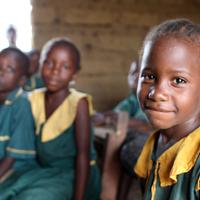New research from Oxford University’s Collen Programme based at the Oxford Institute of Population Ageing has found that increasing education of young girls will have a significant impact on future food demand, and thus the ability to feed the world this century.
Professor Sarah Harper Director of Oxford Institute of Population Ageing said -
“Reaching replacement level fertility by the middle of the century would reduce the population in Sub-Saharan African population by nearly half a billion, and by around 1 billion by the end of the century. Crucially this would also reduce the food gap in Sub-Saharan Africa by 25%, reducing the area of land needed for extra food by the middle of the century by the size of Germany”.
The research was undertaken in collaboration with the World Resources Institute, collaboration between Oxford demographers and WRI food security specialists.
“Research has shown that improving girls’ education, alongside reducing infant and child mortality, and increasing access to reproductive health services, could help the world achieve replacement level fertility by 2050 – and that most of that would occur in Sub-Saharan Africa. Our collaboration with the food specialists in the WRI has now allowed us to put those figures into the real impact on the ability of the world to feed itself" said Harper.
Africa is already the world’s hungriest continent. According to FAO, 25 percent of Sub-Saharan Africa’s people are undernourished. Sub-Saharan Africa could reduce the challenge of feeding its population if it were to steadily lower its present total fertility rate of 5.4 enough to reach replacement level fertility of around 2.1 by 2050, instead of the projected rate of 3.2.
According to the Oxford Institute of Population Ageing, reaching replacement level fertility would result in a sub-Saharan African population of 1.76 billion by 2050. This figure is almost 400 million fewer people than UNDESA’s medium-fertility scenario projection for 2050. If the region maintained replacement level fertility thereafter, the population would be 3.1 billion by 2100 instead of the 3.9 billion projected by UNDESA’s medium-fertility scenario— a tripling rather than a quadrupling of population.
Importantly, this change would reduce food demand in 2050 by approximately 600 trillion kcal per year, roughly 9 percent of the global calorie gap between 2006 and 2050. More significantly, it would reduce the food gap in sub-Saharan Africa by roughly 25 percent. At the yields estimated by FAO, this reduction would also reduce the need for additional cropland equal to the size of Germany.
“There is now strong evidence that achieving replacement level fertility in a way that respects human rights requires improving education opportunities for girls, reducing infant and child mortality, and increasing access to reproductive health services. While these measures are valuable in their own right, in addition we now have evidence of the benefits to food security,” said Sarah Harper.
Education increases the age at which a woman gives birth to her first child, which is a strong indicator of how many children she will ultimately have. Education also helps a woman diversify and increase her income opportunities, which typically enhances her role in deciding how many children to have.
Most of the world’s regions have already achieved, or nearly achieved, replacement level fertility rates. The global exception is Sub-Saharan Africa, which had a total fertility rate of 5.4 from 2005 to 2010. The high fertility in the region will in turn result in a large group of young people who will enter their childbearing years over the subsequent decades, so the region’s population will grow to a total of 3.9 billion in 2100—more than a four-fold increase from 2012 levels.
.jpg)
Notes
“Replacement level fertility” is the total fertility rate at which a population replaces itself from one generation to the next, without migration. It generally refers to 2.1 children per woman. (The “total fertility rate” is the average number of children a woman would have assuming that birth rates remain constant throughout her reproductive lifetime).
The Oxford Institute of Population Ageing is a multi-disciplinary Research Institute based at the University of Oxford which researches into the implications of global age compositional change.
The Collen Programme is researching the fertility transition in Africa and is funded by the Life Sciences Partnership.
www.ageing.ox.ac.uk
World Resources Institute
WRI is a global research organization that works closely with leaders to turn big ideas into action to sustain a healthy environment—the foundation of economic opportunity and human well-being.
www.wri.org









.svg_square_xs.jpg)

